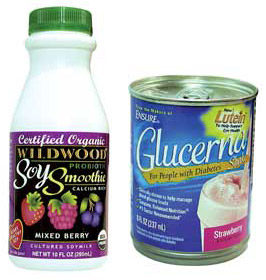
Demographic trends, consumer surveys and sales statistics all point to “gold in them there hills” when it comes to mining consumer interest in healthful products. Yet, as gold miners have discovered, much gravel must be panned before nuggets are uncovered.
Many surveys investigate consumer knowledge and attitudes toward wellness products; however, few research the opinions and intentions of the manufacturers developing products for those consumers. A new 2003 Functional Foods Trends Survey by Prepared Foods does just that.
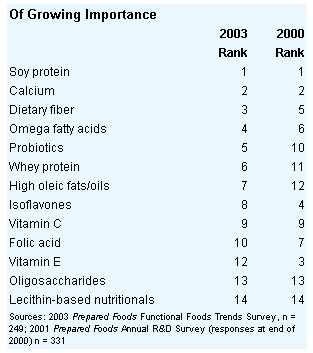
Aren't All Foods Functional?
Allen thinks of functional food as a matter of evolution. First, man's relationship to food was one of basic survival—all foods were of interest. In developed countries, man's relationship with food evolved to one of “indulgence”—with sweet, salty or high-fat products being easily obtained. In the next stage, consumers were driven by “conscience” to look to foods with reduced fat, salt, etc. Now, the focus is on ingredients or positive nutrition and those products that impact health and well being, notes Allen.Many—from consultants to agencies such as the National Institute of Health's (NIH) (Washington) Institute of Medicine—have strived to define the term “functional food”; however, no U.S. regulatory definition exists. When Prepared Foods' survey asked, “How would you define 'functional food'?” (with multiple responses allowed), 63% identified it as a food “marketed to provide a specific health benefit,” while 52% agreed that it was a “nutritionally beneficial” food. Some 41% responded that it was one with “nutraceutical ingredients, such as herbs and bioactive medicinals,” and 30% defined it as a food with “any added nutritional fortifier.”
Despite widespread use of the term, the industry may be drifting away from it.
“Manufacturers are starting to understand that the term 'functional foods' does not make sense to consumers and has different interpretations within the industry,” says Lynn Dornblaser, editorial director, GNPD, Mintel International (Chicago). “Instead, they are developing 'wellness products.' This term is more easily understood and communicated to consumers.”
Regardless of the terminology, 59% of those with marketing and/or sales responsibilities say they currently are developing or marketing functional foods, while 50% of those in R&D and QC feel their companies are doing so. Of those not now in the market, 10% in marketing/sales say their company will be doing so in the next couple of years, versus 7% of those in R&D/QC.
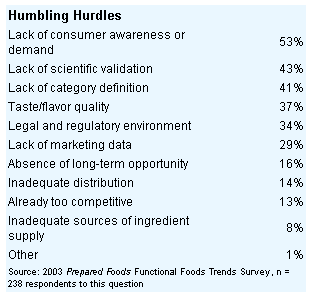
Product Differentiation
Terminology is one of the lesser challenges faced by companies entering the functional foods arena. Allen lists some concerns.“There are relatively few success stories,” he notes. Large companies currently are exiting the area, and there have been dramatic product failures. Furthermore, taking an international approach is difficult. Additionally, there is varied acceptance by the healthcare community. Dietary supplements have suffered much negative publicity in the last few years, and this has spilled over into functional foods. “Consumer needs are not yet leading the science; this is mainly a marketing problem, not a technology problem,” Allen adds.
The Prepared Foods' survey quantified the greatest challenges as seen by manufacturers. Indeed, “lack of consumer awareness or demand” topped the list, with 53% of respondents saying this was one of the top three challenges. This rank at the top also serves as a testimony to the industry's marketing orientation. “Lack of scientific validation” won second place, with 43%.
Lowest cost or product differentiations are two fundamental ways to compete in a marketplace. Between consumer education efforts, research support and ingredient cost, functional foods do not lend themselves to compete on price. Thus, Allen notes, a product must offer a clearly superior benefit.
“Marketing [functional foods] to consumers is a challenge and carries a price,” says Mary Mulry, senior director of product development and standards, Wild Oats Markets (Boulder, Col.). She predicts more emphasis on clinical support and proprietary products because of the difficulty of competing by “just putting a bunch of stuff together.”
One tactic, promoted by ingredient suppliers, is through the use of branded and/or patented ingredients. NutraSweet, the “mother of all branded/ patented ingredients,” is most familiar to the food industry.
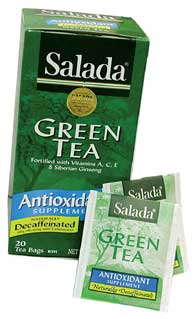
When asked to “rate the importance of co-branding of nutraceutical ingredients in your product,” 11% of respondents to the Prepared Foods' survey said it was “very important,” 47% regarded it as “somewhat important,” and 42% found it “not at all important.”
“Brands say something to the trade or retailers, but few are recognized by natural products consumers,” offers Mulry. “You really need to have a proprietary position to make it worthwhile for a company to single source an ingredient. It's more like a partnership, which is difficult for companies.”
Use of a branded and/or patent-protected ingredient “can be a double-edged sword,” agrees Leslie Skarra, principal, Merlin Development, (Plymouth, Minn.). “Patent-protection conveys 'innovative,' but it also conveys 'single supply source,' which is a large concern.”
If considering a patent-protected ingredient, Skarra suggests first looking up the patent to determine the strength of the claims. The second step is to explore alternate pathways to accomplish the same task.
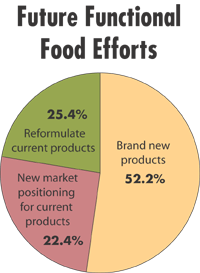
A “formulation” issue ranked fourth on the list of functional food challenges. Some 37% of respondents marked “taste/flavor quality.”
Wildwood Harvest Foods (Watsonville, Calif.) offers soy-based smoothie and yogurt-type products with added nutritional ingredients. Jeremiah Ridenour, CEO of Wildwood Harvest, says, “Consumers are used to the flavor and texture of dairy products, and creating convincing alternatives from soybeans is difficult. We had the added challenge of meeting nutritional and health goals. This pushed us into developing innovative and proprietary processes to come up with a thick and creamy cultured product without the use of added gums and starches.”
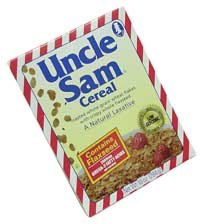
Going for the Gold
Despite the tribulations, survey respondents are exceedingly positive about the future of functional foods. When asked to forecast the growth or decline of functional foods in the next two years, 142 respondents predict an average increase of 31%; only two people feel the category would decline. The median figure given for an estimated increase or decrease was 20%. “Overall, I am quite positive about the future of functional foods,” adds Nestle's Allen.Consumer surveys and demographic statistics assist manufacturers in finding opportunities within the natural and healthful products area. Their interpretation of these opportunities was investigated with the survey question: “What ingredient characteristics or benefits present the greatest opportunity for your product development efforts?”
As in past Prepared Foods' surveys, “natural ingredients” topped the list, reflecting the broad application and vague nature of the term.
Cardiovascular health and cholesterol reduction followed closely, with 45% of respondents checking both of these. Weight loss came in fourth, with 37% of respondents saying it was one of the top three opportunities. (See chart “Opportunities that Knock.”)
With a bit of work, a number of these benefits can be captured in one product, as is the case with the Wildwood Harvest products. “Calcium is known to be often lacking in the American diet. And, people associate calcium with dairy foods but don't expect to find it in a soy product. We thought that was worth doing. We chose probiotics because, in studying nutritional trends in both Asia and Europe, we discovered a growing trend toward the consumption of cultured products, and that they have documented health benefits. Heart healthy was chosen because of a long history of soy providing benefits to the heart. The FDA has now recognized that and allows the heart healthy claim on products containing at least 6.25g of soy protein,” explains Ridenour.
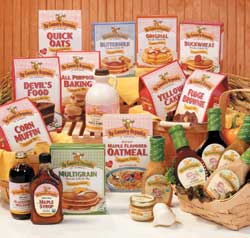
Most Applicable Categories
The industry's enthusiasm towards functional foods can be best seen in responses to the question, “What category of products offers your company the greatest opportunity for developing functional foods?”Although the beverage, health bar and RTE (ready-to-eat cereals) categories are often top-of-mind for this type of positioning, a broad range of categories were seen as having potential. That is, although 13% did check off beverages (the highest ranked category), 12% checked off dairy products, 11% processed meats/poultry/seafood, 9% baked goods and 7% snacks/health bars. Other “votes” were spread across more than 10 other categories.
This diversity reflects those surveyed. Another section prompted responses to, “My responsibilities involve product development for: (with multiple responses allowed).”
Some 32% checked off baked goods, 26% beverages, 24% dairy foods and snack bars each, 23% meals/entrées and so on down to 10% that worked with dietary supplements and 8% with pet foods.
Natural vs. Organic
Some 49% of survey respondents checked “natural ingredients” as an opportunity, 33% saw “organic ingredients” as such.Noting in a March press release that “American families want more than natural—they want organic,” Up Country Naturals of Vermont (St. Johnsbury, Vt.), manufacturer of a line of dressings and bakery mixes, announced it was changing its name to Up Country Organics of Vermont. A spokesperson at the company also commented “'natural' has no standards.” For Up Country, which has been making organic certified products since 1996, being more closely identified with a regulated (and, thus, a more challenging) category is logical.
For others still trying to decide whether to go “natural or organic,” price, image and general feasibility must be weighed.
“Organic can be significantly more expensive for consumers,” says Dornblaser. “There is an incomplete understanding of what is an organic product. As a manufacturer of a natural product, you may not have all the draw that an organic product would bring, but you won't likely lose a lot of customers…and may gain some, due to the cost differential.”
“Price can be relevant,” agrees Mulry. “Also, there are limitations in terms of organic production and availability, especially for specialty ingredients.”
Indeed, 48% of respondents to the survey noted “inadequate sources of ingredient supply” as one of the top three challenges to the development of organic foods. “lack of scientific validation” fell into second place, checked off by 42% of respondents, and “Lack of consumer awareness or demand” garnered 38%, to land in third. Write-in comments repeatedly listed “cost.”
“Natural and organic will both have a place,” says Mulry. She also predicts the term “natural” will evolve to a stricter definition. For example, by the Code of Federal Regulations, it could be argued that modified starch qualifies as natural since it does not contain synthetic colors, preservatives, etc. However, for the Wild Oats stores, Mulry makes a distinction between ingredients “free from” added synthetic, functional ingredients and those from natural sources and processes, that is, closer to the regulated definition for natural flavorings.
Despite the challenge in identifying a market opportunity and then developing products to take advantage of that opportunity, the enthusiasm expressed by the industry for functional, natural and organic products means these will continue to be hot categories.

Sidebar: Ingredient Interests
Prepared Foods' survey asked, “During the next two years, do you expect the following ingredients to become more or less important in your functional foods formulation efforts?” The term “antioxidants” was checked most often with 49%, followed by soy protein and then calcium.“Antioxidants are getting a lot of press. It sounds like everything is an antioxidant, which may be true,” offers Mary Mulry, Wild Oats, only half in jest. Consumer awareness of soy and calcium is high, driven by products for women. The FDA allows a soy protein/heart health link, of course.
Clinical substantiation often is given as an important, if not crucial, element for an individual ingredient's success, but “consumers are not necessarily willing to pay for the support,” says Mulry. “Consumers may pay 10-15% more for added value, but going higher puts you into the 'drug arena.'”
Hunt's with lycopene in its ketchup or Welch's with its grape juice are notable exceptions in that they are taking advantage of ingredients innate to their product.
Indeed, in this year's survey, 26% and 24% of responses checked off lycopene and lutein as growing in importance for their product line. Lutein is derived from marigold flowers.
Through the years, Prepared Foods' surveys have added and dropped ingredients or ingredient categories. A comparison can be made by listing ingredients, by their rank, from the survey taken this year versus one at the end of 2000. Soy proteins have remained the top ranking protein, but changes have occurred further down on the list.
Sidebar: See for Yourself
The purpose of the 2003Prepared FoodsFunctional Foods Trend Survey is to examine trends in the development and growth of opportunities in functional, organic and natural food products amongPrepared Foodsreaders. The participants were chosen from PF's domestic circulation base and sent to the following titles: 50% R&D/QC, 20% general management, and 30% marketing/sales. The sample was selected on an Nth name basis, within each title segment.A direct mail survey instrument was designed for the study by the market research staff of Business News Publishing Company (BNP) (Bensenville, Ill.). The survey was confidential, and individual responses were not identified.
In addition to the overview presented here, other questions addressed topics such as services desired from nutritional ingredient suppliers, reader educational needs, and which applications are looked to as having the best opportunities.
The report can be obtained for $175. For more information, see www.PreparedFoods.com and click on “Special Reports” under “Resources” on the left side of the home page.
 Claudia Dziuk O'Donnell is Chief Editor and Associate Publisher of Prepared Foods magazine including its NutraSolutions and Culinary sections. Her responsibilities include determining the editorial content of the print publication and the New Products Conference.
Claudia Dziuk O'Donnell is Chief Editor and Associate Publisher of Prepared Foods magazine including its NutraSolutions and Culinary sections. Her responsibilities include determining the editorial content of the print publication and the New Products Conference.